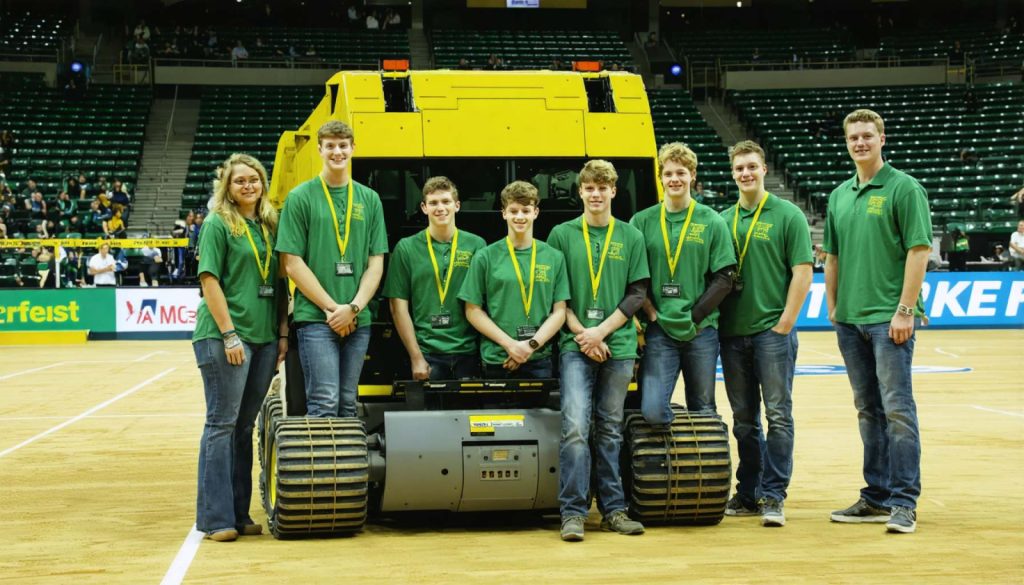
- Arkansas Tech University’s team of nine students achieved a top-three finish at the 2025 IEEE Region 5 Robotics Competition, showcasing resilience and skill.
- The team excelled in three core areas: chassis design, programming, and electronics, under the mentorship of Dr. Zahra Zamanipour.
- The night before the competition, they exemplified adaptability by creating an impromptu practice course in their hotel.
- The students demonstrated remarkable teamwork, transforming challenges into a podium finish that earned them a $300 prize and valuable life lessons.
- Arkansas Tech’s Engineering and Computing Sciences programs, accredited by ABET, provide rigorous training and practical experience.
- Their success highlights the importance of collaboration and experiential learning in engineering education at Arkansas Tech.
Deep in the heart of the bustling town of Wichita, Kansas, the shimmer of inspiration and hard-fought determination glistened more brightly than any trophy. Arkansas Tech University’s spirited cohort of nine students dared to dream big at the 2025 IEEE Region 5 Robotics Competition. Their journey, unfettered by past disappointments, led them to a triumphant top-three finish amidst fierce competition.
With the wind of ambition at their backs, these nine students—each hailing from different corners of Arkansas—manifested a vision through the adroit orchestration of three core competencies: chassis design, programming, and electronics. Their collaborative synergy was palpable as they forged a unity that was both structural and philosophical, guided by the nurturing mentorship of Dr. Zahra Zamanipour, an assistant professor of electrical engineering at ATU.
Arriving in Wichita armed with grit and resilience, the team confronted the night before competition with industrious fervor. Fueled by a quest for redemption and the lingering taste of last year’s shortfall, they devised an impromptu practice course in their hotel—materials freshly procured from a local store in town. This nocturnal escapade of trial and strategy adjustments morphed into a crucible where nascent ideas were tested and honed.
From the first gleam of daybreak, their tireless labor bore fruit as the competition unfurled. The team’s unyielding commitment transformed fatigue into finesse, culminating in a performance that drew admiration and a well-deserved podium finish. Their reward: a $300 check and an even more valuable trove of life lessons—woven from the threads of teamwork, leadership, and adaptability.
These prodigious students, mentored by stalwarts like Jacob Weidenfeller and Dr. Carl Greco, prove that Arkansas Tech’s Department of Engineering and Computing Sciences is a cauldron of potential. Its programs, renowned for their rigor and accredited by ABET, offer a fertile ground for students to cultivate the practical ingenuity required in today’s technological landscape.
“Engineering at Arkansas Tech is not merely an academic pursuit; it’s a transformative journey,” remarked one of the team members, reflecting on a shared odyssey from wide-eyed novices to seasoned competitors. Their narrative, vibrant with both struggle and triumph, underscores a crucial insight: success is sculpted not just in classrooms, but in the crucible of collaboration and practical engagement, such as IEEE’s immersive initiatives.
As they savor this monumental achievement, these young engineers have solidified a legacy—a testimony to the boundless power of dedication and teamwork. At Arkansas Tech, what you sow with passion, you harvest in accolades.
Curious about the programs propelling these achievements? Explore more about Arkansas Tech University’s engineering offerings [here](https://www.atu.edu/stem/engineering/electrical/index.php).
How Teamwork and Innovation Propel Success: Lessons from the IEEE Region 5 Robotics Competition
Insights & Predictions from Arkansas Tech’s Robotics Triumph
The impressive performance of Arkansas Tech University (ATU) students at the 2025 IEEE Region 5 Robotics Competition highlights a growing trend in educational methodologies and team dynamics. As the competitive landscape evolves, the power of interdisciplinary collaboration and the application of practical skills in engineering education is more vital than ever.
Team Dynamics and Collaborative Success
This case from ATU underscores the significance of strong teamwork and leadership in achieving engineering feats. The adept combination of diverse talents in chassis design, programming, and electronics reveals that multi-disciplinary approaches are essential to thrive in complex technological challenges.
Real-World Use Cases and Industry Trends
Robotics Competitions as a Real-World Classroom
– Such competitions serve as a microcosm of real-world engineering challenges, allowing students to apply theoretical knowledge in a controlled yet unpredictable environment. This hands-on experience is invaluable in preparing students for the intricacies of industry work.
– The collaborative model adopted by ATU reflects broader industry trends where cross-functional teams are tasked to innovate rapidly while maintaining quality and functionality.
How-To Steps & Life Hacks
Preparing for a Robotics Competition: Key Steps
1. Team Assembly and Role Assignment: Identify each member’s strengths and assign roles accordingly (e.g., project manager, lead engineer, programmer).
2. Design and Planning: Create a robust project timeline and design schematic. Use CAD software to design chassis and model your robot.
3. Prototype Development: Build a basic prototype for initial testing and adjustments.
4. Iterative Testing and Refinement: Continuously test and refine your design, ensuring all systems work cohesively.
5. Adapting Strategies on the Fly: Stay flexible and ready to adapt strategies based on test outcomes or competition rules.
6. Team Practice Sessions: Create mock competition scenarios to simulate high-pressure environments.
Market Forecasts and Educational Trends
Growth in Robotics Education
– The demand for robotics and engineering education is on the rise, as noted by the Bureau of Labor Statistics’ projection of a 4% growth in engineering jobs through 2030. Robotics-focused programs are increasingly integrated into university curriculums to meet industry needs.
Reviews & Comparisons
Arkansas Tech University Engineering Programs
– The ATU Department of Engineering and Computing Sciences offers an ABET-accredited program renowned for its balance of theory and practical application, preparing students for diverse careers in engineering.
Competitive Landscape
– Similar institutions like MIT and Stanford also promote competitive student involvement through robotics clubs, offering a well-rounded education that blends academic rigor with experiential learning.
Actionable Recommendations
1. Engage in Extracurriculars: Students should participate in competitions to gain practical exposure and experience.
2. Seek Mentorship: Leverage mentorship from faculty and industry professionals like Dr. Zahra Zamanipour for guidance and insights.
3. Focus on Interdisciplinary Learning: Embrace the integration of varied engineering disciplines to solve problems from multiple perspectives.
For those interested in following in the footsteps of these successful students, or aiming to learn more about the programs that support such achievements, explore Arkansas Tech University’s offerings.
These strategic efforts and the nurturing environment at ATU serve as a model for aspiring engineering students and emphasize the transformational power of education fueled by passion and teamwork.



